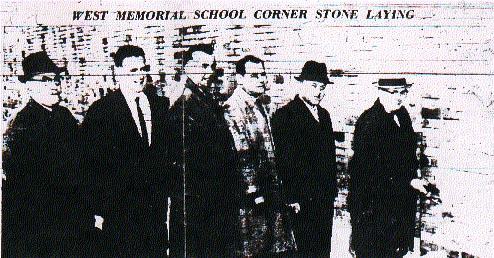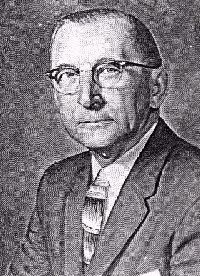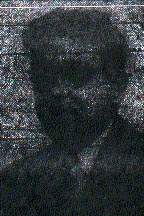
By Dom DiBiase
There was much interest in why the West is called the West and if the school should be named for an individual.
The school's former principal, Eugene Staid (Appendix 2) told us he wasn't clear on whether it was they couldn't decide on a name or if there was too much competition for the school's name.
When the school was built, the community was still honoring war dead. The school was given the name "West Memorial" to memorialize all the people from West Peabody who had served in the military. The name "West Memorial School" was recommended by Post 153 of the American Legion.
While the school was under construction, many suggestions of names for the new school were submitted to the school board.
Joseph Smith of Lowell Street recommended naming the school in honor of an early West Peabody family, the Ingrahams.
The Martin family recommended naming the facility the Martin School. Mary F. McIntire outlined the past and present owners of the site of the new school and recommended that it bear a local name.
Julia B. Fischer of Lowell requested the new school be named the Stephen Needham School.
The West Peabody Grange and the West Peabody Community Club expressed favor for the name Giles Corey, after the witch hysteria martyr.
William B. Moore suggested the name "West School".
At a meeting of the school board in June 1961, shortly after Superintendent William A. Welch, Sr. (Appendix 3) announced his retirement, Mayor Philip C. O'Donnell said that "the testimonial dinner being arranged to honor Superintendent Welch was a deserving tribute, but that it is more desirable that a more lasting tribute be paid to Superintendent Welch for his services in the cause of education in Peabody." O'Donnell then moved that the new Bow Street school be named the William A. Welch Elementary School.
Stating that he did not desire this honor and did not know in advance that such a proposal was to be made, Welch expressed his desire to retire from the meeting while this matter was under discussion and withdrew to his office.
O'Donnell withdrew the motion after it received a mixed reaction from members. One called the move "surprising and sudden", another objected to naming buildings for living persons and another favored naming in honor of historical figures.
Mr. Charles Zindaris of Prospect Street requested the school be named in honor of Dr. George E. Mortis, M.D., a native of Peabody who died in the service of his country in World War II. Before the school board decided on a name in September, several other names were nominated, including: John L. Vagge (Appendix 4), Dr. John Lane, Frank J. Lynch and Alicia B. McNiff (Appendix 5).
What are the unique features and programs on the school?
By Dom DiBiase
are Inside the West Memorial School principal's office, there is a mural of old Peabody. Only people who go in the principal's office get to see this historical resource. The mural was painted by Susan Gleason, who was an art teacher in the Peabody school department. A parent of a West School student did the calligraphy on the mural.
The mural depicts scenes from Peabody's past, including: the Peabody Institute, the George Peabody House, A.C. Lawrence Leather; the cityís Lexington and Civil War monuments, the Sutton Mansion and the fields of the St. Joseph's Juniorate where the Northshore Mall was later built.
At the rear of the school there is a park named Jubilee Park. It has swings, tire swings, and tunnels for the children to play in. The park was refurbished and named in 1991 as part of the city's 75th Jubilee.
The West Memorial garden was dedicated to principal Eugene
Staid (appendix 5) when he retired. A bench was put in the
park in his honor and a plague was placed on the door of the school's computer
room in his honor.
[Source: Interview with Eugene Staid at the West Memorial School, March 1998)
From The Peabody Times, Dec. 7, 1961
West Memorial School Corner Stone Laying

From the Peabody-Lynnfield Weekly News, June, 1996
Eugene P. Staid
More than 350 people filled the schoolís gymnasium to pay tribute to Staid, who served for 14 years as the schoolís educational leader and for 34 years as an employee of Peabody public schools.
On his last day of work, Staid was surprised by the staff and student body with a musical tribute. Each class at the school took to the stage to perform a mix of patriotic songs and familiar tunes with changed wording which allowed the students to sing their praises of Staid. For instance, the students in grade two performed to the melody of "Yankee Doodle" but changed the chorus to read "Mr. Staid is leaving now, Isnít that a pity? We have been the bestest school in all the city."
"It doesnít get any better than this for anyone who has been a teacher," Staid told the assembly of students, co-workers, parents and members of his family. "When you work at a job so long youíre bound to have some small degree of success," he said before thanking the schoolís staff and Parent Teacher Organization for their dedication and support through the years.
Staid asked the 400 students at the school to "make a silent promise to yourself and see if you can follow it for Mr. Staid. From now on these are the things you need to do: always be honest with yourself and others and above all, respect everyone. Be patient with other people and respect their feelings and listen to your parents and teachers."
With coins collected by students and a donation from the West PTO, a new garden was created at the school in Staidís honor. A bench in a small landscaped area carved out of the front of the school bears a plaque dedicating the garden to Staid.
When he sat down on the new bench on Tuesday morning, he was immediately joined by a crowd of adoring kindergartners. At the end of the musical tribute, Staid was surrounded by children seeking to give him a hug and several teachers wiped away tears.
Another plaque honoring Staid appears on the door to the newly equipped West School computer center.
Madilyn Caggiano, Assistant Principal at the West School said, " Mr. Staid has been an integral part of whatís happening with technology in this building and he has been a moving force in the accelerated reader program."
Mayor Peter Torigian presented Staid with a silver Revere bowl and complimented him for his leadership, saying, "We went through the 4 percent cap and proposition 2-l/2 together. It was a traumatic time for a lot of people and Gene Staid did it with a lot of dignity. He stood his ground and did what it took for his school...On behalf of the entire city, thanks for 34 years of service."
State Representative John Slattery said, "We donít come here to celebrate his retirement, thatís nothing to celebrate. We donít want Gene to retire....Your lifeís work is really what weíre honoring. You left your hand print on so many students. We seem to forget in our society whatís important to celebrate. Often its athletes and movie stars but itís the teaching profession we should emulate. Itís teachers and people like Gene Staid who are the true heroes in Peabody and in Massachusetts."
Slattery presented Staid with a citation from the House of Representatives.
The staff at the school gave Staid two large albums filled with photographs of events at the West School and McCarthy schools.
From the program of the Dedication Ceremonies at the Welch School

"May my students be my most perfect verse,
And may I leave in them my most melodious song,
Against that day when my lips no longer sing."
Mr. Welch served the City of Peabody from 1924 to 1961, first as a high school teacher from 1924 to 1933 and then as Superintendent of Schools from 1933 to 1961. His tenure saw new and unique problems for Peabody and he, ever alert to new developments in economics, sociology and education, met these changes.
Rehabilitation projects were begun with additions to the Keefe and Brown Schools. His administration saw the construction of the South Memorial, Center and Kiley Schools and the planning of the West Memorial School.
During the early years of his tenure he was instrumental in establishing the Vocational High School.
In addition to his administrative duties for the City of Peabody, he was a part-time professor of education at the Boston College Graduate School of Education. He was also a former professor at the summer sessions of Boston University and of the Boston College School of Education award as the outstanding school administrator of New England.
He received his Bachelor of Arts and Master of Arts degrees from Boston College and his Juris Doctor degree from Suffolk University Law School;, where he was president of the Senior Class.
During World War I he served as a Lieutenant and Staff Officer.
On his retirement as Superintendent in 1961, Mr. Welch became Executive Secretary of the Massachusetts Association of School Superintendents.
His organizational memberships included the following: New England Association of School Superintendents; President of the Massachusetts Association of School Superintendents; President of the Harvard Round Table; North Shore Superintendentsí Association; Superintendents' National Century Club; Massachusetts Bar Association; Superintendents' National Century Association of School Administrators; Honorary Life Member of the Massachusetts Parent-Teachers Association; a member of the North Shore Association for Retarded Children.
Mr. Welch was a past commander of Peabody American Legion Post 153; past president of the Peabody Rotary Club; former director of the Peabody Chapter, American Red Cross; former finance chairman of the North Shore Council, Boy Scouts of America; a former member of the Peabody Library and Lyceum Committee; an honorary member of Leo Council, 508, Knights of Columbus; first president of the Holy Name Society, St. Ann's Church, South Peabody.
Upon his retirement, after 37 years in the field of education, former Commissioner of Education, Owen B. Kiernan, referred to Mr. Welch as "Mr. Massachusetts Education".
We are proud to dedicate this school to a man whose life was dedicated to education.
From The Peabody Times, May 31, 1956

School committeeman John L. Vagge, 56, well known local electrical contractor died at the J.B. Thomas hospital Sunday evening after a brief illness. Born in Genoa, Italy Vagge came to this city from Nashua, New Hampshire some 25 years ago, and was always active in projects aiding the youth. He made his home at 30 Endicott Street.
His first public office came during the McGrath administration when he was appointed to the park commission and did much to revive the playgrounds and other recreation facilities of the city. He was elected to the school committee, serving one term and then after an absence of four years, was re-elected again last fall for a second term.
A staunch supporter of the Peabody High School band, he
carried on a one man campaign a decade ago to raise money to revive and
rehabilitate the group. He was always interested in athletics and an active
member of the SAS club.
From Alicia M. Guinee in response to the Peabody School History Project search March, 1998
Alicia B. McNiff
I believe my grandmother's name was actually Alicia Mary (Barry) McNiff. Her parents were James and Margaret (Brennan) Barry. Her father owned a leather factory on Foster Street, I think. The family lived on Washington Street in Peabody, in a large white house halfway down the section of Washington Street that runs from Main St. to the intersection with Foster Street. I'd be guessing on the date of birth, but I believe it was one year before the turn of the century, or 1899. She would be 99.
She was one of four siblings, 2 boys and 2 girls. The boys were Arthur and James. Alicia's other sister was Margaret. The family valued education and artistic pursuits. The boys were educated at Princeton and Holy Cross respectively. Alicia attended the New England Conservatory of Music; Margaret was one of the few early women graduates of Massachusetts College of Pharmacy. As you probably know, Arthur J. Barry, a Peabody Hall of Fame member for football, was the Peabody High School Principal for several years.
My grandmother became an accomplished singer in the area. She married James F. McNiff and resided at 35 Gardner St. in Peabody where she raised 8 children, fostering in them the importance of family life, education and a love of the arts, most specifically music. Maggy (McBreen) lives in the McNiff house now, my grandmother having died in 1960 (?) at the early age of about 61. As did my mom (Mary Tierney) and Maggy, my grandmother served on the Peabody School Committee for several years before them. She worked as a teacher in Peabody and was still employed as such as the time of her illness and death.
Given the economic trials of the 1930's, I think raising such a large family must have been difficult. I was told there was significant differences in the conditions of her upbringing versus her married years. From stories I have been told, I gather she was one to withstand adversity and make the best of difficult situations and/or conditions. She seemed to thrive on the good times she experienced with and through her children, acknowledging, though, the pain of such disappointment of a son, Charles, who was stricken with polio as a child and losing another son at an early age to a heart attack.
I believe she was an early model of a working mother! I don't really know the years of her tenure as a teacher, but it seems for those days to unheard of for someone who had (survived raising!) that many children to be working. My mother told me that her mother's family regarded teaching as a profession that would give back to society some of the good experiences an enriched life afforded (but I am sure she wasn't leaving the paychecks behind, either!)
I know she loved her family, loved music, and believed in helping others whenever possible. She loved the beach. Her best friend was Marion Dorgan, whose son, Fr. Gerard Dorgan, is now the pastor at St. Mary's in Danvers. Her 8 children generated 30 grandchildren, and I am sure all of us have been passed a similar sense of love, respect and devotion of Alicia McNiff by her offspring.